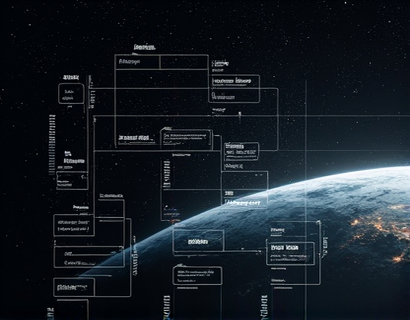Decentralized DAO Governance and Analytics: Leveraging Advanced Software for Transparent and Efficient Organization Management
In the rapidly evolving landscape of decentralized finance and autonomous organizations, the role of governance and analytics has become pivotal for the success and sustainability of Decentralized Autonomous Organizations (DAOs). As DAOs continue to gain traction, the need for robust, transparent, and efficient governance mechanisms and analytics tools has never been more critical. This article delves into the importance of advanced software solutions designed to streamline governance processes and provide detailed analytics, enabling DAO administrators to make informed decisions and foster sustainable growth through enhanced transparency and collaboration.
Understanding DAO Governance
DAO governance refers to the set of rules, protocols, and mechanisms that guide the decision-making processes within a decentralized organization. Unlike traditional hierarchical structures, DAOs operate on blockchain technology, allowing for decentralized and community-driven governance. This model empowers members to propose, vote on, and implement changes, ensuring that the organization aligns with the collective interests of its stakeholders.
The governance framework of a DAO typically includes several key components: token-based voting systems, smart contracts for automating processes, and transparent communication channels. Token holders usually have voting rights proportional to their token ownership, which incentivizes active participation and alignment of interests. Smart contracts ensure that governance rules are executed transparently and immutably, reducing the risk of manipulation and increasing trust among members.
Challenges in DAO Governance
Despite the advantages, DAO governance faces several challenges that can hinder its effectiveness. One major issue is the complexity of governance processes, which can lead to confusion and low participation rates. Another challenge is the potential for strategic voting, where a small group of token holders can manipulate outcomes, undermining the decentralized nature of the organization. Additionally, the lack of standardized governance frameworks and tools can result in inconsistent and inefficient decision-making processes.
To address these challenges, advanced software solutions are emerging to enhance governance transparency, efficiency, and inclusivity. These tools aim to simplify complex processes, provide real-time analytics, and foster a more collaborative environment within DAOs.
Role of Advanced Software in DAO Governance
Advanced software solutions play a crucial role in elevating DAO governance by streamlining processes, enhancing transparency, and providing valuable insights. These tools can significantly improve the overall performance of a DAO by addressing the aforementioned challenges and fostering a more engaged and informed community.
One of the primary functions of these software solutions is to simplify governance workflows. By automating routine tasks such as proposal submission, voting, and outcome notification, these tools reduce the administrative burden on members and ensure that governance processes are executed smoothly and efficiently. This automation not only saves time but also minimizes the risk of human error, enhancing the reliability of governance outcomes.
Streamlining Proposal and Voting Processes
Effective governance starts with a robust proposal and voting system. Advanced software solutions offer intuitive interfaces for proposing and discussing new ideas, allowing members to easily submit, review, and vote on proposals. These platforms often include features such as discussion forums, comment sections, and real-time voting tracking, which facilitate open dialogue and transparent decision-making.
For instance, a proposal can be created and shared with the community, where members can provide feedback and ask questions. The software can then aggregate comments and display them alongside the proposal, ensuring that all relevant information is visible to voters. This transparency helps build trust and encourages higher participation rates. Once the voting period concludes, the software automatically tallies the votes and announces the results, eliminating the need for manual counting and reducing the potential for disputes.
Enhancing Transparency and Accountability
Transparency is a cornerstone of successful DAO governance. Advanced software solutions provide comprehensive audit trails and real-time reporting, allowing members to track the progress of proposals and the execution of decisions. This level of transparency not only builds trust but also holds leaders accountable for their actions.
Blockchain-based logging ensures that all governance activities are recorded immutably, providing an unalterable record of decisions and actions. Dashboards and reports generated by these tools offer a clear overview of governance metrics, such as proposal adoption rates, voting participation, and financial transactions. These insights enable members to make informed decisions and hold the governance team accountable for their performance.
Facilitating Collaboration and Communication
Collaboration and communication are essential for the success of any decentralized organization. Advanced software solutions enhance these aspects by providing dedicated spaces for discussion, collaboration, and knowledge sharing. Features such as chat rooms, project management tools, and document repositories enable members to work together seamlessly, regardless of their geographical location.
For example, integrated project management tools can help teams coordinate tasks, set deadlines, and track progress in real-time. Document repositories ensure that all relevant information is centralized and easily accessible, reducing the risk of miscommunication and ensuring that everyone is on the same page. These features foster a more collaborative environment, where members can contribute their expertise and ideas to drive the organization forward.
Analytics in DAO Governance
Analytics play a vital role in data-driven decision-making within DAOs. By leveraging advanced analytics tools, administrators can gain valuable insights into the performance of governance processes, member engagement, and financial health. These insights enable data-backed decisions that can lead to sustainable growth and improved efficiency.
Key Performance Indicators (KPIs)
To effectively manage a DAO, it is crucial to define and track key performance indicators that reflect the organization's goals and objectives. Advanced analytics software can help identify relevant KPIs, such as voter turnout rates, proposal success rates, community engagement metrics, and financial performance indicators.
For instance, voter turnout rates can indicate the level of community involvement and engagement. High turnout rates generally signify a healthy and active community, while low rates may suggest a need for improved communication or incentive mechanisms. Proposal success rates can reveal the effectiveness of governance processes and the alignment of proposals with community interests. Community engagement metrics, such as forum activity and social media interactions, provide insights into member participation and satisfaction.
Financial KPIs, including token distribution, revenue streams, and expenditure patterns, are critical for assessing the financial health of the DAO. Analytics tools can track these metrics in real-time, providing administrators with a clear picture of the organization's financial status and helping them make informed decisions to ensure long-term sustainability.
Real-Time Monitoring and Alerts
Real-time monitoring and alert systems are powerful features of advanced analytics software. These tools allow administrators to keep a close eye on governance activities and receive immediate notifications when specific thresholds are met or exceeded. For example, an alert can be set to notify administrators when a proposal reaches a certain number of votes or when a financial threshold is approached.
Real-time monitoring ensures that administrators can respond promptly to emerging issues or opportunities, enabling timely interventions and proactive management. This level of responsiveness is crucial for maintaining the smooth operation of the DAO and addressing concerns before they escalate.
Data Visualization and Reporting
Data visualization and reporting tools transform complex data into actionable insights through intuitive dashboards and customizable reports. These features make it easier for administrators to understand and communicate the state of the DAO to both technical and non-technical stakeholders.
Dashboards can display key metrics in a visually appealing format, such as charts, graphs, and gauges, allowing administrators to quickly grasp the overall performance of the organization. Customizable reports can be generated to focus on specific areas of interest, providing detailed insights for in-depth analysis. These reports can be shared with the community, fostering transparency and trust.
For instance, a dashboard might show a overview of recent proposal activity, including the number of proposals submitted, their status, and voter turnout. A report focusing on financial performance could detail revenue sources, expenditure categories, and projected cash flow, helping administrators make informed financial decisions.
Case Studies and Success Stories
To illustrate the practical benefits of advanced governance and analytics software, let's consider a few success stories from DAOs that have implemented these tools.
One notable example is a decentralized finance (DeFi) DAO that adopted an advanced governance platform to streamline its decision-making processes. Prior to implementing the software, the DAO faced challenges with low voter turnout and inconsistent proposal management. By introducing a user-friendly proposal and voting system, the DAO saw a significant increase in participation rates and more efficient governance cycles. The real-time analytics and reporting features provided valuable insights into member engagement and financial performance, enabling the governance team to make data-driven decisions and implement targeted improvements.
Another success story comes from a community-driven content platform DAO. This DAO utilized an analytics tool to monitor community engagement and content performance. By analyzing metrics such as article views, comments, and shares, the governance team identified popular content themes and adjusted their strategy accordingly. The platform also used real-time alerts to notify administrators when community-driven initiatives reached critical milestones, ensuring timely support and recognition. These efforts led to increased member participation, higher content quality, and a more vibrant community.
These case studies demonstrate that advanced governance and analytics software can significantly enhance the effectiveness of DAOs, leading to better governance, higher member engagement, and sustainable growth.
Implementing Advanced Software Solutions
For DAOs looking to leverage advanced software solutions, the first step is to assess their current governance processes and identify areas for improvement. This assessment should involve input from key stakeholders to ensure that the chosen solutions align with the organization's goals and address its specific challenges.
Once the requirements are clear, DAOs can explore various software options available in the market. It is essential to evaluate factors such as ease of use, scalability, integration capabilities, and customer support. Open-source solutions and community-driven projects can also be considered, as they often benefit from active development and a supportive ecosystem.
After selecting the appropriate software, the next step is to implement the solution gradually, starting with pilot programs to test its effectiveness and gather feedback. Training and onboarding sessions should be provided to ensure that all members are comfortable using the new tools. Continuous monitoring and iterative improvements based on user feedback will help optimize the governance processes over time.
It is also important to foster a culture of transparency and collaboration within the DAO. Encouraging members to actively participate in governance and providing clear communication about the benefits of the new tools can drive adoption and maximize the positive impact of these solutions.
Conclusion
In conclusion, advanced software solutions for DAO governance and analytics are essential for modern decentralized organizations seeking to thrive in a competitive landscape. By streamlining governance processes, enhancing transparency, and providing valuable insights, these tools empower administrators to make informed decisions and foster sustainable growth. As the DAO ecosystem continues to evolve, embracing these advanced solutions will be crucial for building resilient, efficient, and community-driven organizations.










































